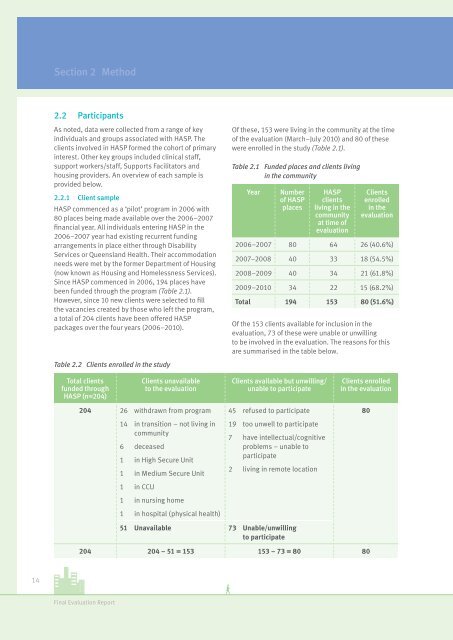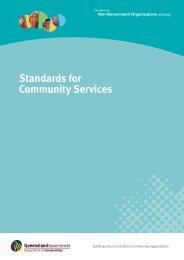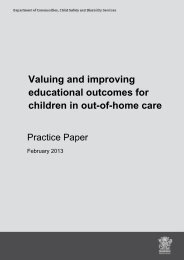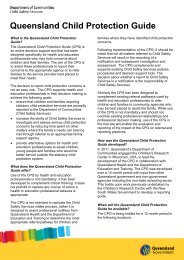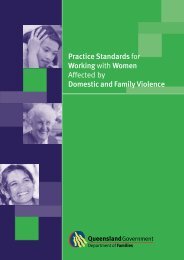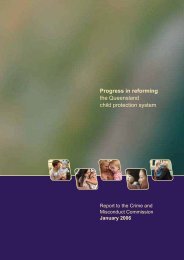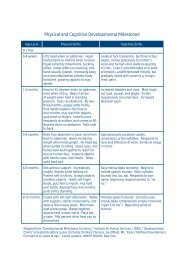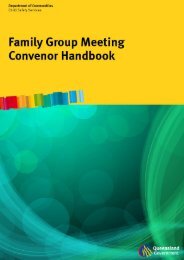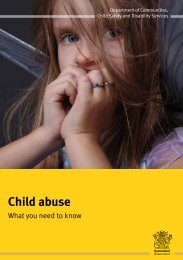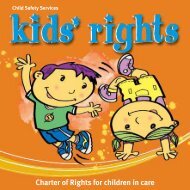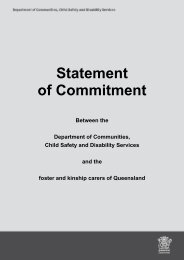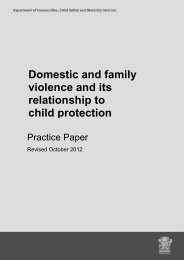Housing and Support Program (HASP): Final Evaluation Report
Housing and Support Program (HASP): Final Evaluation Report
Housing and Support Program (HASP): Final Evaluation Report
Create successful ePaper yourself
Turn your PDF publications into a flip-book with our unique Google optimized e-Paper software.
14<br />
Section 2 Method<br />
2.2 Participants<br />
As noted, data were collected from a range of key<br />
individuals <strong>and</strong> groups associated with <strong>HASP</strong>. The<br />
clients involved in <strong>HASP</strong> formed the cohort of primary<br />
interest. Other key groups included clinical staff,<br />
support workers/staff, <strong>Support</strong>s Facilitators <strong>and</strong><br />
housing providers. An overview of each sample is<br />
provided below.<br />
2.2.1 Client sample<br />
<strong>HASP</strong> commenced as a ‘pilot’ program in 2006 with<br />
80 places being made available over the 2006–2007<br />
fi nancial year. All individuals entering <strong>HASP</strong> in the<br />
2006–2007 year had existing recurrent funding<br />
arrangements in place either through Disability<br />
Services or Queensl<strong>and</strong> Health. Their accommodation<br />
needs were met by the former Department of <strong>Housing</strong><br />
(now known as <strong>Housing</strong> <strong>and</strong> Homelessness Services).<br />
Since <strong>HASP</strong> commenced in 2006, 194 places have<br />
been funded through the program (Table 2.1).<br />
However, since 10 new clients were selected to fi ll<br />
the vacancies created by those who left the program,<br />
a total of 204 clients have been offered <strong>HASP</strong><br />
packages over the four years (2006–2010).<br />
Table 2.2 Clients enrolled in the study<br />
Total clients<br />
funded through<br />
<strong>HASP</strong> (n=204)<br />
<strong>Final</strong> <strong>Evaluation</strong> <strong>Report</strong><br />
Clients unavailable<br />
to the evaluation<br />
204 26 withdrawn from program<br />
14 in transition – not living in<br />
community<br />
6 deceased<br />
1 in High Secure Unit<br />
1 in Medium Secure Unit<br />
1 in CCU<br />
1 in nursing home<br />
1 in hospital (physical health)<br />
Clients available but unwilling/<br />
unable to participate<br />
45 refused to participate<br />
19 too unwell to participate<br />
7 have intellectual/cognitive<br />
problems – unable to<br />
participate<br />
2 living in remote location<br />
51 Unavailable 73 Unable/unwilling<br />
to participate<br />
Of these, 153 were living in the community at the time<br />
of the evaluation (March–July 2010) <strong>and</strong> 80 of these<br />
were enrolled in the study (Table 2.1).<br />
Table 2.1 Funded places <strong>and</strong> clients living<br />
in the community<br />
Year Number<br />
of <strong>HASP</strong><br />
places<br />
<strong>HASP</strong><br />
clients<br />
living in the<br />
community<br />
at time of<br />
evaluation<br />
Clients enrolled<br />
in the evaluation<br />
204 204 – 51 = 153 153 – 73 = 80 80<br />
Clients<br />
enrolled<br />
in the<br />
evaluation<br />
2006–2007 80 64 26 (40.6%)<br />
2007–2008 40 33 18 (54.5%)<br />
2008–2009 40 34 21 (61.8%)<br />
2009–2010 34 22 15 (68.2%)<br />
Total 194 153 80 (51.6%)<br />
Of the 153 clients available for inclusion in the<br />
evaluation, 73 of these were unable or unwilling<br />
to be involved in the evaluation. The reasons for this<br />
are summarised in the table below.<br />
80


